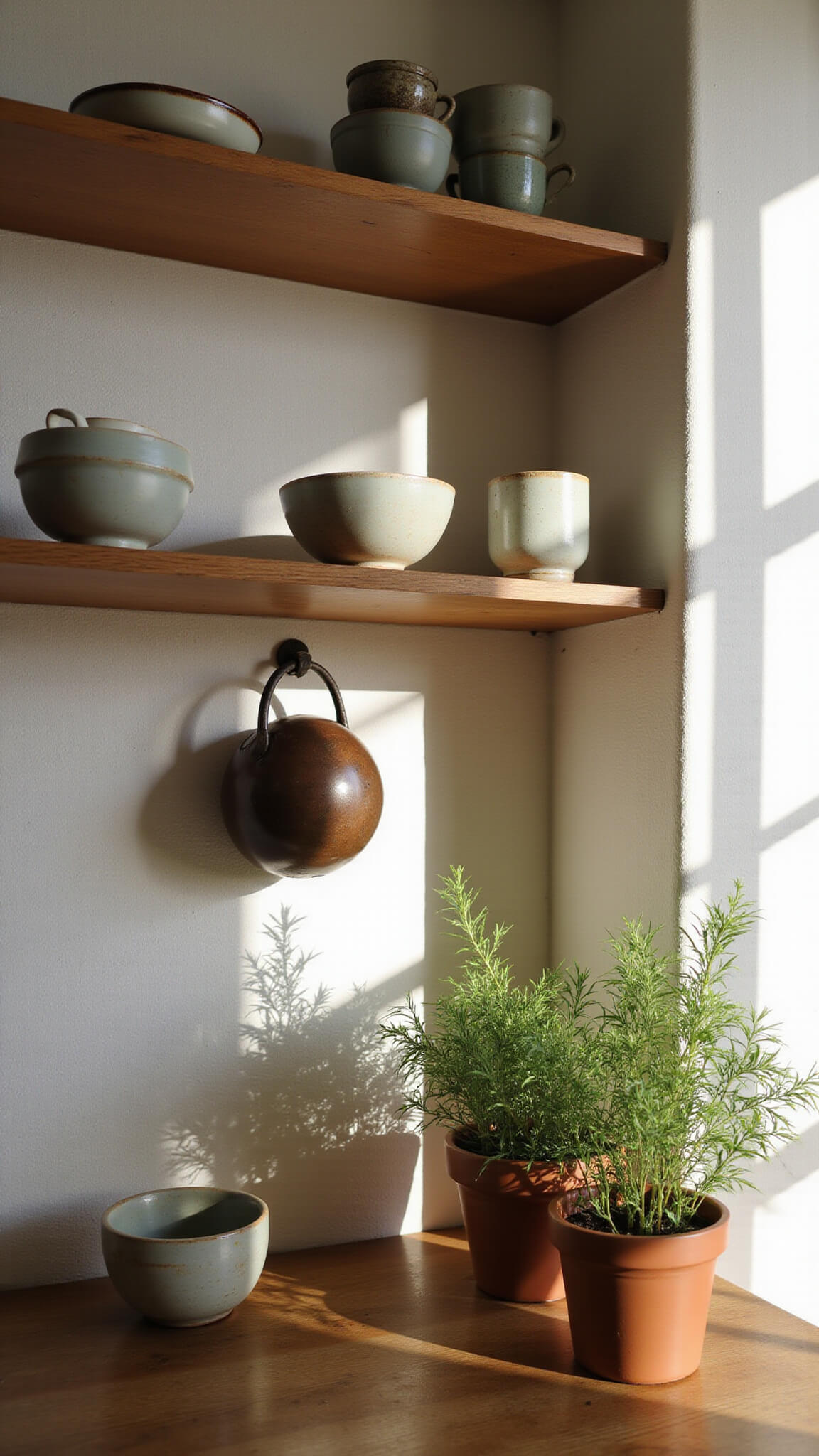Embracing Wabi-Sabi Home Decor: Finding Beauty in Imperfection
Wabi-sabi home decor celebrates the beauty of imperfection and transience in our living spaces. After spending years trying to achieve those perfect, catalog-worthy rooms, I’ve discovered something far more meaningful – the Japanese philosophy that honors weathered surfaces, natural materials, and the authenticity of handmade objects.
I remember walking into my friend’s apartment last year and feeling instantly at peace. The space wasn’t polished or perfect, but it had soul. A cracked ceramic bowl held dried flowers on a weathered wooden table. Sunlight filtered through linen curtains, casting gentle shadows across textured walls. “This is wabi-sabi,” she explained, and I was hooked.
Let me show you how to create this serene, imperfect beauty in your own home.

What Exactly Is Wabi-Sabi Decor?
Wabi-sabi decor draws from ancient Japanese philosophy embracing impermanence and imperfection. It’s the antithesis of our mass-produced, disposable culture.
Think of wabi-sabi as mindful minimalism with a soul. It’s:
- Organic and natural materials showing their age gracefully
- Asymmetrical and irregular shapes that feel handcrafted
- Subtle, earthy colors that create a sense of calm
- Visible history in objects with patina, cracks, or wear
- Intentional simplicity that focuses on what truly matters
Unlike other minimalist styles that can feel sterile, wabi-sabi embraces warmth through texture and natural imperfections.
Essential Elements for Wabi-Sabi Styling
Natural Materials Are Non-Negotiable
The foundation of wabi-sabi decor is honest, natural materials that age beautifully:
- Untreated wood with visible grain and knots
- Raw ceramics with irregular shapes or visible cracks
- Natural fibers like linen, cotton, wool, and jute
- Stone and clay elements with unique patterns and textures
- Tarnished metals that develop character over time
The Wabi-Sabi Color Palette
Forget bold, artificial colors. Wabi-sabi embraces the subtle hues found in nature:
- Clay and terracotta
- Soft beiges and oatmeals
- Muted grays and charcoals
- Gentle whites (never stark)
- Faded indigos
- Mossy greens and sage tones
- Subtle rusts and browns
These colors create a harmonious backdrop that doesn’t compete with natural textures.
Embrace Asymmetry and Negative Space
Perfect symmetry feels manufactured. Wabi-sabi cherishes:
- Off-center arrangements
- Irregular groupings
- Intentional empty spaces
- Uneven numbers of objects
- Varied heights and proportions
Pro tip: Always leave some breathing room around your pieces. That space isn’t empty—it’s purposeful.
Room-by-Room Wabi-Sabi Transformations
Living Room Wabi-Sabi
The living room is where we spend most of our time, making it perfect for wabi-sabi principles:
- Replace perfect throw pillows with handwoven or naturally dyed covers
- Swap out mass-produced art for handmade ceramics on a shelf
- Use a low, weathered wood coffee table instead of glass or high-gloss
- Layer natural fiber rugs in different textures
- Display a single branch in a handmade vase rather than elaborate floral arrangements
- Incorporate stone or clay objects with interesting shapes
Bedroom Serenity Through Wabi-Sabi
The bedroom should be a sanctuary, and wabi-sabi principles enhance this feeling:
- Choose linen bedding in soft, muted tones that improves with washing
- Use unfinished or reclaimed wood for nightstands
- Replace ceiling fixtures with simple paper lanterns or hand-blown glass
- Display a single meaningful object rather than multiple decorations
- Keep floors bare or use natural fiber rugs
- Hang textiles with subtle imperfections as wall art
Wabi-Sabi Kitchen Elements
Even functional spaces benefit from wabi-sabi touches:
- Display handmade pottery rather than matching dishware
- Use wooden cutting boards and utensils that show wear
- Store dry goods in ceramic or glass containers of varied shapes
- Hang hand-forged or vintage utensils
- Incorporate plants in simple clay pots
- Choose open shelving to display imperfect but beautiful everyday items
DIY Wabi-Sabi Projects for Beginners
Kintsugi-Inspired Repair
Kintsugi is the Japanese art of repairing broken pottery with gold, celebrating rather than hiding the damage:
- Find a cracked ceramic piece you love
- Mix food-safe epoxy with gold mica powder
- Fill the cracks carefully, following package instructions
- Allow to dry completely
- Display proudly as a celebration of imperfection
Natural Fabric Dying
Create uniquely colored textiles using natural materials:
- Start with plain white cotton or linen fabric
- Gather natural dye sources (avocado pits for pink, onion skins for yellow, black tea for tan)
- Simmer materials in water for 30-60 minutes
- Strain liquid and add pre-soaked fabric
- Let sit for hours or overnight
- Rinse until water runs clear
- Allow to dry naturally for soft, imperfect color
Weathered Wood Treatment
Create the appearance of time-worn wood:
- Sand raw wood piece to desired smoothness
- Apply steel wool soaked in vinegar for aged pat












